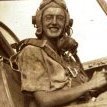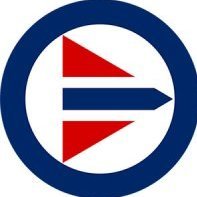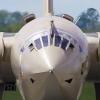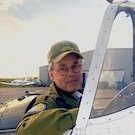Search the Community
Showing results for tags 'romania'.
-
Hi, Savoia Marchetti SM 55 was a very successful design of an Italian flying boat in 1924, so 100 years ago (what?!). It was produced in short series of different variants, which although similar in general outlook differ a lot in details. Almost 250 of them were constructed. The Royal Romanian Naval Aviation (RRNA) got seven Savoia Marchetti SM 55A about 1930. They served till the end of WW2 at least. The WIP is here This is a photo from a private resources, which I have found on Romanian FB, I was trying to follow it assuming Italian Grigio Scuro as top camo color The model is Dora Wing SM 55A kit with some modifications on floats surface (see WIP when need details) Here is the results: This is my second SM 55, the first (SM 55X) was done five years ago from Delta 2 kit in Italian livery from Spanish Civil War. I discussed also many of my doubts in separate threads I am very grateful for all comments in all past threads and in the current one as well. Regards Jerzy-Wojtek #5/2024
-
On signing up, my original plan was an Airfix 1/48 Hunter in Dutch markings. On looking at the original sign up list, I saw that drew the Romanian flag. Knowing knext to nothing about the Romanian armed forces, but being that my sister-in-law’s brother’s wife is Romanian, this got me thinking, so I went off to do some research and some shopping followed. Romania became a member on the 29th March 2004. Having a look on Scalemates I came across the 1/48 Wolfpack MiG-21 LanceR with schemes from 2007 and 2009. Result. The Mig 21 officially was retired from the Romanian Airforce on the 15th May 2023 The Wolfpack LanceR is based on the Academy plastic with added resin from Wolfpack. Don’t know much about the Academy plastic, having only built Eduard MiG-21s to date. So what do you get in the box? Academy Plastic Lots of nice resin.
-
Messerschmitt Bf 109E "Slovak and Rumanian Aces" (SH72472) 1:72 Special Hobby The BF 109 has inherited quite a legendary status and when you look into its service career, it's certainly obvious why. Viewing the design in retrospect, it looks just like a typical fighter of the WWII era, but it was more than that, it was the very platform that the single seat fighter format was born from. Powerful engine, monocoque airframe, all metal construction, enclosed cockpit and retractable gear this was unheard of before hand, it was radical, not typical in the 1930's. Its birth wasn't perfect however, to achieve its performance, some sacrifices were made, particularly in the landing gear arrangement and high wing loading having a negative effect on landing speeds compared to the competition at the time. This inherent design issue was never fully cured and it's estimated that at least 10% of all 109's were lost in take off accidents. Early models (A-D) were powered by the Junkers jumo engine with outputs of around 700hp. The aircraft was first used in combat during the Spanish Civil War where many lessons were learned and these would be later put to good use in battles over France and Britain. The E or Emil model broke the mould in 109 development by changing to the more powerful Daimler Benz DB 601 engine of around 1080hp, a significant step in performance and also in armament due to the introduction of 20mm cannon. By 1939, all earlier variants had been replaced in frontline service. As the variants progressed, so did the level of armour protection for the pilot. Another critical element to improve survivability was the use of twin radiators with cut off valves meaning that if one radiator was damaged, the other could be used to keep it airborne. The Emil was the primary Luftwaffe fighter until 1941 when the F model became widely available with more powerful engine although a few managed to see combat in the Battle of Britain. For an aircraft that broke the mould with fighter technology and performance in the mid 30's, it's evolution meant that whilst it's design had exhausted improvement capability towards the end of the war, it stayed in operational use until 1965 in Europe in the guise of the Spanish licence built HA 1112 using the Merlin power plant. During its 30 year career, more than 33,000 were built, a record that will probably never be beaten. The Kit This a brand new tool for 2020 from Special Hobby, in collaboration with Eduard. The quality is first class with crisp moulding and fine engraved panel lines. Given the small size of the real aircraft, in 1/72 the model is quite diminutive, but seems well detailed. Construction starts with the cockpit. The rear bulkhead attaches to the floor with the rudder pedals going in as well. The front lower bulkhead is made up and installed onto the floor followed by the instruments panel and the coaming in front of it. The instruments being provided as decals. Into the cockpit go the flight controls and flap wheel, followed by the seat. The belts being provided as decals also. If the modeller is going to display the cover for the guns in front of the cockpit open then full guns are included, if you are doing this closed then only partial ones need to be added. Next up the engine is assembled which seems quite detailed for the scale, the bearers attached and it fitted to the firewall. Inside the main fuselage halves the exhausts are fitted along with the tail wheel and then the whole thing can be closed up. Separate engine and gun covers can be added, or left off as needed. After the tail surfaces are attached to the main fuselage then we can move onto the wings. The lower wing is a single part with left and right uppers. The wheel wells are all boxed in on the lower. To the middle of the lower wing the radiator is first added. The top wings can then go on. All the wing control surfaces are separate parts. To finish the wing the under wing radiators are added. The wing can then be joined with the fuselage. The canopy parts can then be added, with different types of head armour being provided for the different decal options. The slats can then be added to the main wing in either the open or closed position as needed. At the front the prop and spinner goes on. Last up for the main parts, the main landing gear is made up and added. A few detail parts now can be added to finish of the kit, the aerial mast, pitot tubes, balance horns,; and even an engine starting handle if you wish to install it. Markings The glossy decal sheet is printed in house and looks sharp and in register. There are four decal options available from the decal sheet; Messerschmitt Bf 109E-3, No.9, W.Nr. 2486, ‘Hai Fetito!’, Lt. Av. Ioan Di Cesare, Escadrila 57, Grupul 7 Vânătoare, Aeronautica Regala Romana (Royal Romanian Air Force), based at Karpovka-Stalingrad, occupied part of the USSR, November 1942. (Box art aircraft) Messerschmitt Bf 109E-7 (rebuilt from an E-3), No.64, W.Nr. 704, ‘Nella!’, Adj. Av. Tiberiu Vinca, Escadrila 56, Grupul 7 Vânătoare, Aeronautica Regala Romana (Royal Romanian Air Force), Karpovka-Stalingrad, occupied part of the USSR, Winter 1942. V Messerschmitt Bf 109E-3, White 2, probably W.Nr. 2945, čtk. Ján Režnák, Slovenské vzdušné zbrane, (Slovak Air Force) 13. (slow.)/JG52, based at Krasnodar, occupied part of the USSR, January 1943. Razňák's final tally stood at 32 victories which ensured him the position of the most scoring fighter pilot of the SVZ. Messerschmitt Bf 109E-7, White 1, rtk. Rudolf Božík, Scramble Flight, Slovenské vzdušné zbrane (Slovak Air Force), Vajnory airfield, the Slovak State, 1943/44. Rudolf Božík, a Slovak Air Force ace pilot with 12 and ½ victories under his belt. Conclusion It is good to see a new tool out of this most famous aircraft. I am no 109 expert but it looks to be a well detailed and engineered kit. Decal options of other users than the Luftwaffe are always welcome. Highly recommended. Review samples courtesy of
-
Kit - Tamiya Paint - All acrylics Decals - LF 48-07 Extras - none Messerschmitt Bf 109E-3 Vanatoare Gr.7 Central Front Summer 1942 The Tamiya 1:48 109E kits are just great for quick builds, yes there are newer and better detailed kits around, but for sheer VFM, the Tamiya kits are hard to beat. I've added only belts made from masking tape and AM decals to this one because I wanted a quick project to keep my recent (Tamiya) Spitfire company on the shelf - also a factor was the very simple two-tone (three if you count the yellow) paint scheme. Nothing else really to say, the paintwork is heavily faded with pre & post shading which unfortunately my phones' camera isn't clever enough to bring-out so you'll just have to trust me on that. Not added the aerial wire yet because the next model show here isn't until November !! The Romanians were supplied a large number of refurbished 109E-3's in early 1941 just prior to the invasion of the Soviet Union, hence the title of the thread. Feel free to ask any questions, make any comments or criticism - yes I have dirtied-up the wheel hubs since I took the pics, they don't look as stark now. Have a great weekend everyone, all the best from a decidedly autumnal Middle Earth. Ian.
-
Bf-109 | 1/72 | Tamiya Lt.Av. Ioan Di Cezare, Romania | Karpovka-Stalingrad, November 1942 Finished this on June 21, 2020. My first Tamiya kit, it may have been one of the best kits I've ever put together. The surface detail is incredible, as good (or maybe better) than the Eduard kits I've built and everything fit very well with no issues at all. I had next to no seam work to do and the kit decals, which I've heard many complaints about, seemed to be just fine for me. The Romanian marking decals are by RB productions and were superb. This subject is the mount of Ioan Di Cezare, who was credited with 16 victories and 3 probables. General Di Cezare died in Bucharest in 2012. This is not my best build because of a couple things out of my control. First, the yellow on the decals and the Hataka RLM yellow I used were quite different. I really didn't notice until I started decals -- I should've compared the decals to the paint early in the build, but foolishly made the assumption that since they were both RLM 04 yellow, the match would be pretty close. Looking at some resources of mine, I've gathered that the decals are a little too orange to be RLM 04, and the Hataka paint is probably not orange enough. So... nuts. The other major problem is I had to open a brand new can of testors dullcote about 75% of the way through dull coating the model and the new paint frosted up terribly (Picture below). Luckily I was able to remove the bad dullcote without damaging the decals using mineral spirits (the full saga is at: https://www.britmodeller.com/forums/index.php?/topic/235075369-has-testors-dullcote-changed/ ). Unfortunately, the only dull coat paint I had around was Testor's acryl dull coat. I've found Testor's acryl paint to be terrible, so I wasn't in a hurry to use the dull coat, but I figured since I wasn't going to be masking over it, it might be OK. A test shot on my paint mule showed that it looked OK, so I proceeded. Against the dark RLM 71 on the model, it didn't look so great. From a couple of feet away it is fine, but under a magnifying glass the finish is milky and kind of blurs the decals. I probably could've stripped it again and ordered something better, but from a couple feet away, it looks OK. The bottle of Acryl has since been thrown in the trash and some other dull coat on order. I used SBS resin wheels, which are top-notch, and I used Montex canopy masks, which were not very good. I read a review of montex masks that said they are made of thick vinyl and will not stick to curves. Since the E-3 has a curved canopy, I was aware that I might not be able to use all of the masks, but I was mainly concerned with the small windows around the windshield. The review was right: the masks would not stick to curves at all, so I had to cut some out of tamiya tape. These were the only E-3 canopy masks I could find, though. Paint: Mr. Surfacer 1500 black decanted into airbrush > Hataka RLM 02 (cockpit and landing gears) / Hataka RLM 71 (top) / Hataka RLM 65 (bottom) / Hataka RLM 04 (theater markings) > Testor's dullcote decanted into airbrush / Testor's Acryl flat top coat Decals: Kit decals for stencils, RS Production RBD72012 Romanian Markings Aftermarket: SBS wheels Good sidewall detail, unlike Hasegawa: And the dullcote disaster: Thanks for looking! Comments, questions and constructive criticism wecomed!
-
Heinkel He 111-H3 Romanian AF (48266) 1:48 ICM via Hannants The He.111 was originated in secrecy, disguised as a civilian transport in the mid-30s, but once Nazi Germany came out of the closet and disregarded the Versailles agreement, it immediately became clear that they were rearming in a major way. The early civilian and military variants had a more traditional stepped canopy, and there is a famous piece of film that is used and reused in documentaries showing a D or "Dora" variant dropping bombs during the Spanish Civil War as part of the Condor Legion, which was Hitler's proving ground for his new designs and Blitzkreig tactics. Various revisions followed until the P, which introduced the now-iconic stepless fully glazed cockpit, which improved both aerodynamics and the pilot's situational awareness. The P series saw limited action in WWII as it was replaced by the more competent H variant, substituting Junkers Jumo 211 engines, detuned to give it the throbbing beat that was to be heard over Britain almost until the end of the war. The H-3 had an improved version of the engine and increased numbers of machine guns for self-defence. As is often the case with wartime development, the end of the Battle of Britain saw the introduction of the H-4 with better engines and external bomb racks. The H series continued until the H-23, although there were also a number of side-projects such as the Z, Zwilling with two airframes joined by a central aerofoil and sporting five engines, designed to tow the Me.321 Gigant glider. The Kit We have only had one choice if we wanted a 1:48 He.111, although it has been in various boxes over the years. It's not a bad kit, but this is a 100% new tooling by ICM, who have raised their game substantially over the recent years. The kit arrives in their lidded top-opened with a glossy card lid and painting to top it off, with seven sprues in medium, grey styrene, one in crystal clear styrene, an instruction booklet in line-drawn colour, and a long decal sheet that can be found ensconced within the booklet. On opening the bags, it is very apparent that this is a modern tooling, with lots of lovely details, crisp moulding, and some very clever engineering on display. The cockpit and partial interior will require some thought for painting, but if you get the order right, you should minimise the swearing when you have to reload the airbrush for the Nth time. Construction starts with the two wing spar parts, which are separated by the gear bay roof assemblies and a walkway part. Additional detail is added to the bulkheads along with the fuselage walkways and a smaller bulkhead toward the tail, with the lower portion of the mid-upper "turret" ring attached to the floor. The cockpit floor is then assembled with rudder pedals, instrument panels, seat and control linkages, slotting into the front spar once finished. An additional chair and the overhead instrument panel are installed later in the build. As a prelude to closing up the fuselage, the tail wheel is fitted together, which has the wheel moulded-in, and consists of three parts. Preparation of the fuselage halves involves adding the inserts into the wing roots and making good the join; inserting the paired side windows; adding ammo can racks; radio panel; the pilot's control column, and more glazing in the ventral gondola. The spar/cockpit assembly is then fitted to the starboard fuselage half and the port side is added along with some glue. The rudder is separate and fits to the fin with actuators, then the missing fuselage panels between the spars are added, which of course will need painting and fettling in if you're bothered about the "endoscope brigade". The mid-upper insert is designed to cater for different "turret" installations, and has a lovely serrated ring moulded-in, with controls and bracing strut added before it is installed into the fuselage opening, closing off much of the rear fuselage. You can pose the bomb bay open or closed by selecting one of the two panels, one of which has opening for the bomb bay, where the bombs are suspended tail-first in a framework that is peppered with lightening holes so that the included bombs are visible within. The bombs themselves are built up from two halves that have two fins moulded-in, and a single part that fits on the tail forming the other two fins in a cruciform layout. To these are added stiffening brackets, with four bombs in total to make. With the bomb bay finished, it is inserted into the fuselage from below, filling yet another gap in the skin. Even if you are leaving the bays closed, the bomb bay can be seen from the side windows, so it's best to build that assembly and install it anyway to prevent that section from being see-through from the sides. At this point the wings are begun, with the lower sides added to the fuselage/spar assembly first. The ailerons are separate, and are built up before the uppers are added, as are the elevators, and the two engines, which are provided in their entirety, along with much of the ancillary equipment and engine mounts. The completed Jumo 211s are fitted to the front of the spars and depending on whether you want to display them or not, and then enclosed by cowling panels, radiators and the intake/outlet ramps. The bottom cowlings can be split to reveal the engine detail, which is a good way of showing off the detail without ruining the lines of the aircraft. The upper wings and ailerons are fitted, the remaining cowling panels with the exhausts are added, with the latter having a decent indent at the tip to simulate being hollow, and finally the nose glazing, which has a machinegun and the aforementioned overhead instrument panel, which is moulded in clear styrene and is provided with a decal for the instruments. The nose "cone" is a separate clear part, and it too is fitted with a machine gun with a choice of single or twin drum mags and dump bag for the spent brass. Another two MGs are fitted to the front and rear glazing on the gondola, and the mid-upper gun is added to the turret ring, along with the protective clear shroud at the front. The main wheels are each built up from two halves, and placed between the twin legs that have the main retraction jacks moulded in, and secured with a number of cross-braces between the two legs. An additional ram is fitted within the bay, attached to the rear cross-brace. The gear bay doors fit to the bay sides with large tabs, as do the bomb bay doors if you are using them, and these last parts have the correctly separated four "petals" that are seen on the real thing, rather than a single panel. The props are made up from a single part with two part spinner and back plate, which fit onto the engine's output shaft through the vented front of the cowlings. Markings There are two decal options included in the box as suggested by the tite for the Romanian Air Force. both in the Green/Brown/Grey camo scheme, . From the box you can build one of the following: He.111H-3, 5th Bomber Group, Romanian Air Force, Bessarabia, Summer 1941 He.111H-3, 5th Bomber Group, Romanian Air Force, Russia, Late 1942 Decals are printed by ICM, with good registration, sharpness and colour density, with a thin gloss carrier film cut close to the printed areas with a few exceptions around some of the fuselage codes. These can easily be cut off before they are applied however, so it's not an issue. The triple white bars on decal option 2 can be seen in some photos (Google image search "he 111 1a+da"), and those on the starboard wing appear to have a substantial amount of overspray around the trailing rectangle, which could be fun to replicate yourself. Conclusion The He.111 is a truly iconic shape, and we're long overdue a new tooling of the type in this scale. ICM have done a great job of it by the looks of things. Very highly recommended. Available in the UK from importers H G Hannants Ltd. Review sample courtesy of
-
Hello everyone, At the risk of being a bit OTT on the WIP threads (this will be my third ongoing thread, though the other two are approaching their end, so it's not too bad), I wanted to share with you my first ever (I think) Bf109 build. I might have built one as a kid, but if I did, it made no impact on me. I haven't built many WW2 German subjects since coming back to the hobby, but I have a few in the stash. Actually, there's only one aircraft in my cabinet that bears any Luftwaffe markings, and that's the most recent completion (an Eduard Bf110E). This kit has jumped the stash-queue, as I only bought it on ebay this week. It's the Airfix 2010 boxing. From a first inspection, the detail is a little soft, but then I'm hardly the best modeller out there, so maybe we're a good match! Anyway, this boxing comes with decals for a 1942 Romanian airframe, which is a colourful, if busy, scheme, and I can't resist it. There's a little info on the pilot, Tiberiu Vinc, here: https://www.asisbiz.com/il2/Bf-109E/FARR/pages/Messerschmitt-Bf-109E7-FARR-7-Grupul-Esc56-Yellow-64-Vinca-Tiberiu-WNr-704-Stalingrad-1942-0A.html I think this'll be OOB only, Box art, scheme, and sprue shots: Thanks for looking in.
-
Just started this one typical Azur production . cheers Jes
-
Calling this one done - earlier stuff can be seen here. Comments/thoughts/abuse appreciated! Have fun... Iain
- 17 replies
-
- 16
-











